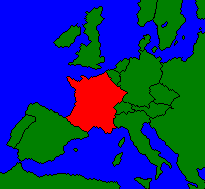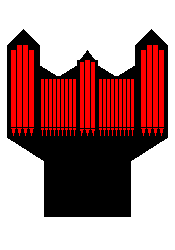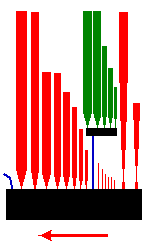

Seventeenth and Eighteenth Century France
|
| Divisions and Position | Stops | Compass | Review Quiz |
| Grand Orgue | Positif | Récit | |||||||||||||||||||||||||||||||||||||||
|---|---|---|---|---|---|---|---|---|---|---|---|---|---|---|---|---|---|---|---|---|---|---|---|---|---|---|---|---|---|---|---|---|---|---|---|---|---|---|---|---|---|
| Montre | 16 | Bourdon | 16 | Cornet V | |||||||||||||||||||||||||||||||||||||
| Bourdon | 16 | Montre | 8 | ||||||||||||||||||||||||||||||||||||||
| Montre | 8 | Bourdon | 8 | Echo | |||||||||||||||||||||||||||||||||||||
| Bourdon | 8 | Prestant | 4 | Cornet V | |||||||||||||||||||||||||||||||||||||
| Prestant | 4 | Flûte | 4 | ||||||||||||||||||||||||||||||||||||||
| Flûte | 4 | Nazard | 2 2/3 | Pédale | |||||||||||||||||||||||||||||||||||||
| Tierce | 3 1/5 | Doublette | 2 | Flûte | 8 | ||||||||||||||||||||||||||||||||||||
| Nazard | 2 2/3 | Tierce | 1 3/5 | Trompette | 8 | ||||||||||||||||||||||||||||||||||||
| Doublette | 2 | Larigot | 1 1/3 | ||||||||||||||||||||||||||||||||||||||
| Quarte de Nazard | 2 | Fourniture IV | Tremblant doux
| Tierce | 1 3/5 |
| Cymbale IV | |
| Tremblant fort
| Fourniture IV | |
| Cromorne | 8
|
| Cymbale IV |
|
| Cornet V |
|
| Trompette | 8
|
| Clairon | 4
|
| | |||||||||||||
| Sample Stoplist | Divisions and Position | Stops | Compass | Review Quiz |
Divisions and Placement | |
| In the French Classical case, there is no visual evidence of the number of divisions you can expect to find in the main organ. The stoplist above has four manual divisions and a pedal: | |
| The Positif will be located in its own case, of course, behind the player, and is generally played from the first manual, counting from the bottom. |
| As its name implies, the Grand orgue is the primary division of the main case; its pipes form the façade and it is played by the second manual. |
| The pipes of the Récit are also located in the main case, although you don't see them. This small division typically has a short compass, beginning on middle c, and is played by the third or fourth manual, depending on the presence of an Echo division. The chest for this division is located above the main chest, in an elevated position. As you can see in the stoplist above, there is typically only one stop, a five-rank Cornet. |
| The division is located in the main case, but is placed below the chest of the Grand
orgue. The name of this division was used by several builders in the early part of the twentieth
century
to indicate a division located in a remote part of the room. In the French Classical Echo,
however, the
effect of distance is achieved by the placement of the pipes in a position where they cannot speak
clearly
into the room: en fenêtre ("in the window"), i.e., behind the panel or music
rack
above the top manual keyboard.
Like the Récit, the French Classical Echo also has a short compass and is normally played by the third manual. |
| The pipes of the Pédale division stood on the same chest as those of the Grand orgue. They were divided and the pipes placed at the ends of the chest. One of the typical features of the stoplist above is that the lowest pitches appear on the Grand orgue, not the Pédale. The longer pipes of the 16' Montre would normally have been in the façade, and the pipes of the Pédale would not be visible. |
| Although you can expect any French Classical organ to have Grand orgue, Positif, and Pédale divisions, there isn't always a consistency in the other two. Sometimes an organ had a Récit but no Echo, sometimes the reverse. | |
| Sample Stoplist | Divisions and Position | Stops | Compass | Review Quiz |
Stops | |
|
Take a look at the stop names in the Grand Orgue and Positif, and find the principals.
On any French Classical organ, the name used for a 16' or 8' principal is Montre,
and you can expect to find the lower-pitched principal on the Grand orgue. The other stops
of the principal chorus also had specific names:
|
| Each division has two chorus mixtures that complete the harmonic series of principal-toned stops. Both are made up of octave- and quint-sounding ranks, and, like similar compound stops in the lowlands and Germany, they are survivors of the Medieval Blockwerk. On either single division, the Fourniture is based on a lower pitch than is the Cymbale. The two chorus mixtures, though, will always have the same pitch relationship, but not the same absolute pitches. This means that the Fourniture of the Positif is based on a higher pitch than the Fourniture of the Grand Orgue, and the same is true of the two Cymbales: the Positif is higher than the Grand Orgue. |
| Look a second time at the flutes on both the Grand Orgue and the Positif. They are all stops of wide scale, the two Bourdons stopped and the others open.126 The Grand Orgue has more flutes at a greater variety of pitches than would be found on a similar instrument built without French influence, including the Nazard, the Tierces, and the Larigot. In fact, a large number of flute-scaled mutation stops is typical of French Classical organs, and these mutations derive from the harmonic series of the fundamental pitch on either manual division. For example, the Grosse Tierce, at 3 1/5' pitch, is a harmonic of the 16' fundamental on the Grand Orgue, while the Larigot 1 1/3' extends the harmonic series of the 8' fundamental on the Positif. The scales of the Positif flutes might be slightly smaller than those of the Grand Orgue, but the difference in their sound, as heard from the nave, is caused more by their placement closer to the listener - - on the gallery rail, than by their voicing. |
|
A Cornet V, a compound stop of flute scales, is found on three of the four manual
divisions, and the appearance of so many of these stops is one of the most typically
"French" elements of this stoplist.
This particular stop plays only in the treble range, usually from c' to the top of
the keyboard,
distinguishing it from a similar group of individual ranks on Grand Orgue or Positif, which
would play the
full range of the keyboard. You might think that the three Cornets are different in composition,
or that
one is louder, softer,
more piercing or rounder in tone than the others.
It would appear that three stops that sound alike would not be necessary. The three Cornets,
however, are
essentially made alike, and their sounds are quite similar.
The primary differences that let us tell one from the other are
|

|
Internally, the windchests of both Grand Orgue and Pédale are placed at impost level, and all their pipes are standing on that plane - - with the exception of the Cornet of the Grand Orgue. In the diagram to the left, the red shapes represent the pipes of the 16' Montre in the hypothetical organ described above. If you place your cursor over the image, you will see the façade replaced by a view of the interior pipe placement. The blue shapes are the pipes of the Pédale, divided on either side, while the red shapes standing at the same level are those of the Grand Orgue. What appears to be a pair of floating black rectangles with additional pipes is actually the Cornet of the Grand Orgue. |
|
The diagram below is a cross-section of the windchest of the Grand Orgue. The view is from
the side of the
chest, with the façade to the left, as indicated by the arrow.
You can imagine that this is a slice through the chest at middle c (c'), or at any
higher pitch on
the windchest. This chest includes the pallet box, key channels, and
sliders that direct
the wind to individual pipes of selected stops.
| |
| In the diagram, you can see how all the stops of the Grand Orgue are actually played from the same windchest. The blue squiggle that is the first thing coming from the upper side of the chest is a tube that conducts wind to the middle c pipe of the 16' Montre, which is located in the façade. There is a slider for this stop, just as there is for each of the other stops of the Grand Orgue. Moving from left to right, we see the 16' Bourdon, 8' Montre - - all the stops of the Grand Orgue, ending with the 8' Trompette and the 4' Clairon. Between the Tierce and the Fourniture, there is another blue line that leads up to the auxiliary chest where the Cornet pipes (green in the diagram) sit. |
 |
| The extra chest has no pallet box, so it serves only the limited purpose of distributing the wind from a single opening on the topboard of the chest to five pipes. You can think of this arrangement as one that saves space, because the main chest is not as wide as it would be if all the pipes of the cornet were placed on it between the other pipes that play middle c. This helps keeps the case shallow so that sound can be projected better through reflection from the back of the case. A Cornet in this position is sometimes called a "mounted Cornet" because its pipes are "mounted" (monté) above the topboard of the chest from which it plays. Its main purpose is to strengthen the sound of the 8' Trompette in the upper registers, where the sound thins out in the reed pipes. | |
|
The final group of manual stops in the typical French Classical disposition consists
of the reeds, listed to the right.
Both the Trompettes and the Clairon are conical reeds with full-length resonators, while the
Cromorne is a
short-length cylindrical reed, and the Clairon was simply a Trompette at the higher octave.
The Cromorne was
made to balance the Trompette, and in the Parisian organ typically produced an equivalent volume
of sound.
In larger instruments, two additional reeds might be found:
|
| The only two stops in the Pédale are both at 8' pitch. The Flûte is an open stop, and like most open flutes, its color is almost that of a soft principal in the lower registers. The Trompette is similar to the one of the Grand Orgue. |
|
The two tremulants each affected the entire organ, not just single divisions.
|
|
The French Classical organ typically had some mechanism for coupling the Positif to the
Grand orgue, so that the stops of the smaller division could be played from the primary
manual. The usual manner of accomplishing this was through what is commonly called
in the United States by the German term Scheibekoppel. In operating a coupler of
this type the
player grasps the key cheeks of the Grand orgue
manual and literally moves the entire keyboard - - "shoves" it, to use the English
cognate to scheiben - - either forward or backward to engage or disengage the
coupling action.
Couplers from any one of the manuals to pedal were not commonly found on these instruments, and the music of the period does not require them. |
| Sample Stoplist | Divisions and Position | Stops | Compass | Review Quiz |
Keyboard Compass |
| Both manual and pedal keyboards in the French Classical organ commonly
began on the note C, as do keyboards on organs in the United States today.
Manual keyboards typically extended to c" or d", pedals to c'.
Short
octaves were common.
One distinguishing trait of the French compass was the occasional inclusion of AA - - a third below the lowest C of the keyboard. On some instruments an additional key was provided, on others the low C# key played the AA, C# being omitted as it would be in a short octave. |
| Sample Stoplist | Divisions and Position | Stops | Compass | Review Quiz |
© 1999, 2000 James H. Cook